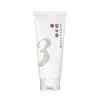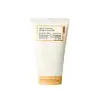What's inside
What's inside
 Key Ingredients
Key Ingredients

 Benefits
Benefits

 Concerns
Concerns

 Ingredients Side-by-side
Ingredients Side-by-side

Glycerin
HumectantWater
Skin ConditioningCellulose
AbsorbentSodium Cocoyl Glycinate
CleansingSodium Lauroyl Glutamate
Kaolin
AbrasiveDisodium Cocoamphodiacetate
Cleansing1,2-Hexanediol
Skin ConditioningHydrated Silica
AbrasiveLauryl Betaine
CleansingSodium Chloride
MaskingSodium Methyl Cocoyl Taurate
CleansingHydroxyacetophenone
AntioxidantEthylhexylglycerin
Skin ConditioningAcrylates/C10-30 Alkyl Acrylate Crosspolymer
Emulsion StabilisingCitric Acid
BufferingPolyglycerin-3
HumectantHexylene Glycol
EmulsifyingButylene Glycol
HumectantHydrogenated Lecithin
EmulsifyingFicus Carica Fruit Extract
HumectantCentella Asiatica Extract
CleansingBeta-Glucan
Skin ConditioningCeramide NP
Skin ConditioningCarbomer
Emulsion StabilisingHydroxypropyl Starch Phosphate
Glycerin, Water, Cellulose, Sodium Cocoyl Glycinate, Sodium Lauroyl Glutamate, Kaolin, Disodium Cocoamphodiacetate, 1,2-Hexanediol, Hydrated Silica, Lauryl Betaine, Sodium Chloride, Sodium Methyl Cocoyl Taurate, Hydroxyacetophenone, Ethylhexylglycerin, Acrylates/C10-30 Alkyl Acrylate Crosspolymer, Citric Acid, Polyglycerin-3, Hexylene Glycol, Butylene Glycol, Hydrogenated Lecithin, Ficus Carica Fruit Extract, Centella Asiatica Extract, Beta-Glucan, Ceramide NP, Carbomer, Hydroxypropyl Starch Phosphate
Water
Skin ConditioningGlycerin
HumectantSodium Cocoyl Glycinate
CleansingOryza Sativa Bran Water
MaskingCellulose Gum
Emulsion StabilisingSodium Lauroyl Glutamate
Hydrated Silica
AbrasiveKaolin
Abrasive1,2-Hexanediol
Skin ConditioningSodium Sweetalmondamphoacetate
CleansingLauryl Betaine
CleansingSodium Methyl Cocoyl Taurate
CleansingSodium Polyacrylate
AbsorbentCitric Acid
BufferingSodium Chloride
MaskingEthylhexylglycerin
Skin ConditioningHydroxyacetophenone
AntioxidantAcrylates/C10-30 Alkyl Acrylate Crosspolymer
Emulsion StabilisingZea Mays Germ Oil
EmollientPolyglycerin-3
HumectantParfum
MaskingPhytosteryl/Octyldodecyl Lauroyl Glutamate
Skin ConditioningButylene Glycol
HumectantCaprylic/Capric Triglyceride
MaskingHydroxypropyl Methylcellulose
Emulsion StabilisingHydrogenated Lecithin
EmulsifyingPaeonia Suffruticosa Root Extract
Skin ProtectingCentella Asiatica Extract
CleansingFicus Carica Fruit Extract
HumectantBeta-Glucan
Skin ConditioningBiosaccharide Gum-1
HumectantCeramide NP
Skin ConditioningPentaerythrityl Tetra-Di-T-Butyl Hydroxyhydrocinnamate
AntioxidantTocopherol
AntioxidantHydroxyethylcellulose
Emulsion StabilisingEctoin
Skin ConditioningHydrolyzed Hyaluronic Acid
HumectantOryza Sativa Bran Oil
EmollientOryza Sativa Extract
AbsorbentPhytosphingosine
Skin ConditioningOryza Sativa Lees Extract
Skin ConditioningLactobacillus/Rice Ferment
Skin ConditioningProtease
ExfoliatingSodium Phytate
Sodium Dna
Skin ConditioningBromelain
Skin ConditioningOryzanol
Skin ConditioningPapain
Skin ConditioningLipase
Skin ConditioningKojic Dipalmitate
EmollientWater, Glycerin, Sodium Cocoyl Glycinate, Oryza Sativa Bran Water, Cellulose Gum, Sodium Lauroyl Glutamate, Hydrated Silica, Kaolin, 1,2-Hexanediol, Sodium Sweetalmondamphoacetate, Lauryl Betaine, Sodium Methyl Cocoyl Taurate, Sodium Polyacrylate, Citric Acid, Sodium Chloride, Ethylhexylglycerin, Hydroxyacetophenone, Acrylates/C10-30 Alkyl Acrylate Crosspolymer, Zea Mays Germ Oil, Polyglycerin-3, Parfum, Phytosteryl/Octyldodecyl Lauroyl Glutamate, Butylene Glycol, Caprylic/Capric Triglyceride, Hydroxypropyl Methylcellulose, Hydrogenated Lecithin, Paeonia Suffruticosa Root Extract, Centella Asiatica Extract, Ficus Carica Fruit Extract, Beta-Glucan, Biosaccharide Gum-1, Ceramide NP, Pentaerythrityl Tetra-Di-T-Butyl Hydroxyhydrocinnamate, Tocopherol, Hydroxyethylcellulose, Ectoin, Hydrolyzed Hyaluronic Acid, Oryza Sativa Bran Oil, Oryza Sativa Extract, Phytosphingosine, Oryza Sativa Lees Extract, Lactobacillus/Rice Ferment, Protease, Sodium Phytate, Sodium Dna, Bromelain, Oryzanol, Papain, Lipase, Kojic Dipalmitate
 Reviews
Reviews

Ingredients Explained
These ingredients are found in both products.
Ingredients higher up in an ingredient list are typically present in a larger amount.
1,2-Hexanediol is a synthetic liquid and another multi-functional powerhouse.
It is a:
- Humectant, drawing moisture into the skin
- Emollient, helping to soften skin
- Solvent, dispersing and stabilizing formulas
- Preservative booster, enhancing the antimicrobial activity of other preservatives
Acrylates/C10-30 Alkyl Acrylate Crosspolymer is a synthetic polymer. It is used to thicken and improve the texture of products. Due to its properties, it can prevent water and oil ingredients from separating.
Beta-Glucan is a polysaccharide. It can be derived from the cell walls of seaweed, oats, yeast, and fungi. It hydrates the skin and helps boost your skin's natural barrier.
As an antioxidant, beta-glucan helps fight free-radicals. Free-radicals are molecules that may damage your skin cells, such as pollution.
Studies show this ingredient may be an effective wrinkle reducer as it can deeply penetrate into skin. It has also been show to help with wound healing.
Learn more about Beta-GlucanButylene Glycol (or BG) is used within cosmetic products for a few different reasons:
Overall, Butylene Glycol is a safe and well-rounded ingredient that works well with other ingredients.
Though this ingredient works well with most skin types, some people with sensitive skin may experience a reaction such as allergic rashes, closed comedones, or itchiness.
Learn more about Butylene GlycolCentella Asiatica Extract (Centella) is derived from an herb native to Southeast Asia. It is famous for its anti-inflammatory and soothing properties.
Centella is rich in antioxidants and amino acids, such as Madecassic Acid and Asiaticoside.
Studies show the compounds in centella help with:
The combination of all these properties makes centella effective at soothing, hydrating, and protecting the skin.
Other great components of centella include Vitamin A, vitamin C, several B vitamins, and Asiatic Acid.
Fun fact: Centella has been used as a medicine and in food for many centuries. As a medicine, it is used to treat burns, scratches, and wounds.
Learn more about Centella Asiatica ExtractCeramide NP is a type of ceramide and formally known as ceramide 3.
Ceramides are intercellular lipids naturally found in our skin that bonds dead skin cells together to create a barrier. They are known for their ability to hold water and thus are a great ingredient for dry skin.
Ceramides are an important building block for our skin barrier. A stronger barrier helps the skin look more firm and hydrated. By bolstering the skin ceramides act as a barrier against irritating ingredients. This can help with inflammation as well.
If you would like to eat ceramides, sweet potatoes contain a small amount.
Read more about other common types of ceramides here:
Ceramide AP
Ceramide EOP
Citric Acid is an alpha hydroxy acid (AHA) naturally found in citrus fruits like oranges, lemons, and limes.
Like other AHAs, citric acid can exfoliate skin by breaking down the bonds that hold dead skin cells together. This helps reveal smoother and brighter skin underneath.
However, this exfoliating effect only happens at high concentrations (20%) which can be hard to find in cosmetic products.
Due to this, citric acid is usually included in small amounts as a pH adjuster. This helps keep products slightly more acidic and compatible with skin's natural pH.
In skincare formulas, citric acid can:
While it can provide some skin benefits, research shows lactic acid and glycolic acid are generally more effective and less irritating exfoliants.
Most citric acid used in skincare today is made by fermenting sugars (usually from molasses). This synthetic version is identical to the natural citrus form but easier to stabilize and use in formulations.
Read more about some other popular AHA's here:
Learn more about Citric AcidEthylhexylglycerin (we can't pronounce this either) is commonly used as a preservative and skin softener. It is derived from glyceryl.
You might see Ethylhexylglycerin often paired with other preservatives such as phenoxyethanol. Ethylhexylglycerin has been found to increase the effectiveness of these other preservatives.
Ficus Carica Fruit Extract comes from the fruit known as the fig. Figs are rich in antioxidants and helps hydrate the skin.
Figs also contain fatty acids and Vitamins A, B1, and B2.
As a humectant, figs are able to draw moisture from the air to your skin. This helps keep your skin hydrated.
Learn more about Ficus Carica Fruit ExtractGlycerin is already naturally found in your skin. It helps moisturize and protect your skin.
A study from 2016 found glycerin to be more effective as a humectant than AHAs and hyaluronic acid.
As a humectant, it helps the skin stay hydrated by pulling moisture to your skin. The low molecular weight of glycerin allows it to pull moisture into the deeper layers of your skin.
Hydrated skin improves your skin barrier; Your skin barrier helps protect against irritants and bacteria.
Glycerin has also been found to have antimicrobial and antiviral properties. Due to these properties, glycerin is often used in wound and burn treatments.
In cosmetics, glycerin is usually derived from plants such as soybean or palm. However, it can also be sourced from animals, such as tallow or animal fat.
This ingredient is organic, colorless, odorless, and non-toxic.
Glycerin is the name for this ingredient in American English. British English uses Glycerol/Glycerine.
Learn more about GlycerinHydrated Silica is a type of silicon dioxide. It is called 'hydrated silica' because it is silica with extra bonded water atoms.
It is an absorbent and abrasive, meaning it is exfoliating.
Silica is often used for absorption and can help reduce shine when products are applied.
Learn more about Hydrated SilicaHydrogenated Lecithin is created from the hydrogenation of lecithin (a group of phospholipids). Hydrogenation is a chemical reaction between hydrogen and another element.
This ingredient is an emollient and emulsifier. As an emollient, it helps soften skin by trapping moisture within. As an emulsifier, it prevents oil and water ingredients from separating.
Hydroxyacetophenone is antioxidant with skin conditioning and soothing properties. It also boosts the efficiency of preservatives.
This ingredient is not irritating or sensitizing.
Kaolin is a clay. It is used for oil control and to help minimize pores. Like other clays, kaolin has the ability to absorb excess sebum or oil. This can help clean out pores and mattify the skin.
Some types of kaolin may have exfoliating properties. When water is added to kaolin, it becomes a paste with small abrasive particles.
Most kaolin is a white color, but may be pink/orange/red depending on where it comes from.
The name 'kaolin' comes from a Chinese village named 'Gaoling'. Kaolin clay comes from rocks rich in kaolinite. Kaolinite, the mineral, has a silicate layered structure. Kaolinite is formed from chemical weathering of aluminum siilicate minerals.
Besides skincare, kaolin is commonly used to make glossy paper, in ceramics, toothpaste, and as medicine to soothe stomach issues.
Learn more about KaolinLauryl Betaine is a surfactant. It helps cleanse your skin by gathering oil, dirt, and other pollutants to be rinsed away.
Polyglycerin-3 is a 3-unit glycerin polymer.
Like glycerin, this ingredient is a humectant. Humectants help hydrate your skin by drawing water to it.
Having moisturized skin helps improve the skin barrier. Your skin barrier helps protect against irritants and bacteria.
Learn more about Polyglycerin-3Chances are, you eat sodium chloride every day. Sodium Chloride is also known as table salt.
This ingredient has many purposes in skincare: thickener, emulsifier, and exfoliator.
You'll most likely find this ingredient in cleansers where it is used to create a gel-like texture. As an emulsifier, it also prevents ingredients from separating.
There is much debate on whether this ingredient is comedogenic. The short answer - comedogenic ratings don't tell the whole story. Learn more about comegodenic ratings here.
The concensus about this ingredient causing acne seems to be divided. Research is needed to understand if this ingredient does cause acne.
Scrubs may use salt as the primary exfoliating ingredient.
Learn more about Sodium ChlorideSodium Cocoyl Glycinate is a cleansing agent. It can be naturally derived or synthetically-created.
As a surfactant, it helps clean your skin by gathering dirt, oil, and other pollutants to be rinsed away more easily.
Sodium Lauroyl Glutamate is the sodium salt from the lauric acid of glutamic acid.
It is a surfactant and helps cleanse the skin. Surfactants gather oil, dirt, and other pollutants from your skin so they may be washed away easily.
This gentle cleansing and foaming ingredient is known for leaving a smooth feeling in skin and hair. It is made using coconut oil.
According to the manufacturer, it is soluble in water and has resistance to hard water, acid, and alkali.
Due to its coconut base, it may not be Malassezia folliculitis safe.
Learn more about Sodium Methyl Cocoyl TaurateWater. It's the most common cosmetic ingredient of all. You'll usually see it at the top of ingredient lists, meaning that it makes up the largest part of the product.
So why is it so popular? Water most often acts as a solvent - this means that it helps dissolve other ingredients into the formulation.
You'll also recognize water as that liquid we all need to stay alive. If you see this, drink a glass of water. Stay hydrated!
Learn more about Water